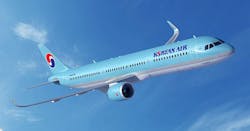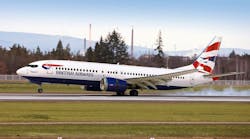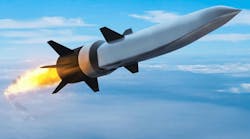Korean Air is ordering 50 737 Max passenger jets from the Boeing Co. in Seattle, as well as 50 A321neo aircraft from Airbus in Toulouse, France. Each order is for 30 aircraft with 20 options. The orders were announced this week at the Paris Air Show in Le Bourget, France.
The order from Boeing, worth about $3.9 billion, includes two 777-300ER long-range jumbo jets. The estimated value of the Airbus order was not released. The Airbus neo designation stands for new engine option. For more Paris Air Show coverage see www.militaryaerospace.com/paris-air-show.
Boeing is designing the 737 MAX family of passenger jets to compete directly with the Airbus A320neo passenger jet family. The 737 MAX will have LEAP-1B engines from CFM International S.A. in Aérodrome de Villaroche, France -- a joint venture of General Electric in the U.S. and Snecma in France. The engines are to be optimized for the 737 MAX, Boeing officials say.
The Boeing 737 Max also has serrated edges called chevrons for the back of the engine nacelle and the engine exhaust nozzle to reduce jet blast noise by controlling the way the air mixes after passing through and around the engine. The 737 MAX aircraft will enter service in 2017.
The Boeing 737 MAX family will consist of three models -- the MAX 7, MAX 8, and MAX 9 -- that will have different lengths and different seating configurations. The new jets will feature the 737 Boeing Sky Interior with spacious cabin headroom, overhead bins that disappear into the ceiling yet carry more bags that previous interior configurations, and light-emitting diode (LED) lighting.
The twin-engine Airbus A320neo family, which is scheduled to enter service in 2016, consists of the latest-model A320, A321, and A319. All the new aircraft offer a choice of the CFM International LEAP-X or the Pratt & Whitney PW1100G PurePower environmentally friendly engines.
The stretched-fuselage A321neo can seat as many as 185 passengers in a two-class layout, or as many as 220 passengers in a high-density cabin. The shorter-fuselage A319neo can seat 124 passengers in two classes or as many as 156 passengers in a high-density cabin setup.
The aerodynamic and engine improvements in the A320neo family offers a 15 per cent reduction in fuel consumption compared with earlier versions, as well as 500 nautical miles of more range, lower operating costs, and reductions in engine noise and emissions, company officials say.
For more information contact Boeing Commercial Airplanes online at www.boeing.com/commercial, Airbus at www.airbus.com, or Korean Air at www.koreanair.com.



